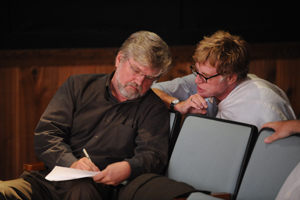
Twenty-five Chinese Ministry of Culture executives just left my office. It was exciting to learn about Chinese cultural investment in projects -- from massive contemporary visual art colonies in Beijing and Shanghai to an exploding phenomenon of cultural festivals in cities and villages throughout their colossal country. They in turn were eager to learn how the arts industry is structured and supported in the United States. As they were leaving my office, 35 French, Belgian and Spanish business leaders arrived with the cultural officer from the French Embassy. They, too, were excited to learn how the arts industry is supported in the United States
Last month, I was brought in to speak to arts groups and government and business leaders in Amsterdam; other Americans for the Arts staff members went or will go to Brussels, London, Korea, and Germany just this fall. Each of these countries wants to learn how the arts industry in America is supported and how private sector giving to the arts works. They are especially curious about how business donations "flow" into the bank accounts of U.S. arts organizations, and to capture the compelling arguments that motivate elected officials to "shower" the arts with public dollars and supportive policymaking in America.
What is going on? World governments are increasingly excited about the economic power of the arts and the value of cultural exchange in a changing world. Because the prodigious levels of government support in Europe and Asia are diminishing, they want to better understand our American advocacy techniques. And as they observe the sea of corporate logos on the backs of most U.S. performing arts programs, they want to know America's secret to eliciting substantial business support for the arts.
However, the leaders from these other countries are often quite disappointed when I tell them that the result of our mightiest, most sophisticated advocacy efforts generates just 9 percent of the total income for U.S. nonprofit arts organizations. Equally disappointing is that private sector support in America is only 31 percent, mostly from individuals. Business support -- despite all the logos and brand recognition -- is only about 5 percent. Yet these foreign leaders and delegations keep coming because they see the breadth of creative and innovative arts organization we have here. They see the freedom of ideas, the variety and the sheer pluck and entrepreneurial spirit of America's arts community.
In September 2009, at the Sundance Preserve, Robert Redford and I convened our fourth National Arts Policy Roundtable for CEOs, elected officials and opinion leaders to discuss how the arts strengthen 21st century global communities by helping create better understanding and stronger relationships between the U.S. and the world .
Thinking about this 21st century global marketplace, four key cultural imperatives jumped out:
- The arts are a global economic force.
- The arts are an aggressive part of today's international competitive marketplace.
- Improved cultural understanding is essential in international dialogue.
- The arts make dramatic contributions to our national security.
The report complements what has been a recent growth of dialogue and interest in making a case for the strength of the arts in U.S. diplomacy and with key decision-makers. Margaret (Peggy) Ayers at the Robert Sterling Clark Foundation has pioneered groundbreaking research on our private sector's role in supporting U.S. cultural exchange. Former Congressman John Brademas, with his Brademas Center for the Study of Congress' Project on Cultural Diplomacy at NYU, is spearheading an effort to reinvigorate Congress' role in supporting the arts in our cultural diplomacy efforts.
Our U.S. State Department is making some positive moves in this direction. Earlier this year, the State Department sponsored a partnership with Brooklyn Academy of Music to take three dance companies on tour throughout the world. More recently, that agency announced a partnership with the Bronx Museum of the Arts to take the work of contemporary U.S. visual artists on tour.
These are good efforts, but more is needed on all fronts. The U.S. government must invest much more than the $10 million or so it now appropriates for use toward international cultural activity. While arts advocacy groups last year proposed that Congress add $10 million to the current amount already appropriated, that dollar amount is just a fraction of what is needed in today's world. Just peak in my office door to see who is interested from across the globe -- our competitors are on our doorstep.
For years, at the local level, city arts commissions and local and state arts councils have hosted cultural and economic delegations from throughout the world and sent similar American delegations overseas in search of economic and cultural partnerships. Sister Cities organizations have often been at the core of such local efforts. This citizen-to-citizen intimacy and the success of such efforts is being celebrated this week in Washington, D.C. at the U.S. Summit & Initiative for Global Citizen Diplomacy, where former Chairman of the National Endowment of the Arts Frank Hodsoll and former U.S. Ambassador Cynthia Schneider have spearheaded an effort recognizing some of our nation's best cultural diplomacy efforts, and honoring leaders such as Robert Redford and the Sundance Institute.
So bravo to the low-budget (or no budget) individuals, communities and states that reach out, one arts action at a time, to help our nation be better understood. And thanks to our U.S. State Department leaders for taking a step toward renewed, rejuvenated partnerships with our very own United States arts resources. I look forward to even bigger leaps and even more successful participation in the future.
